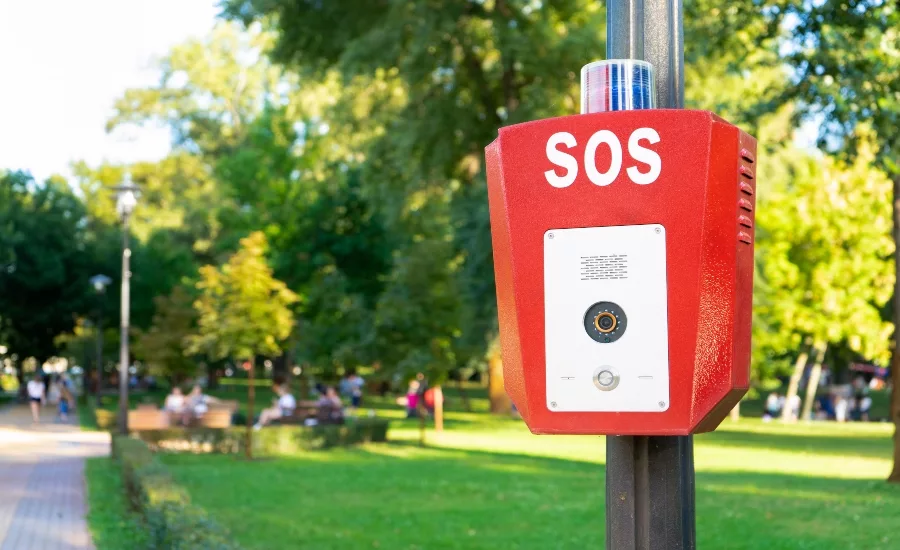How communities can use technology to address gun violence

Over the past year, the United States has battled two major crises: COVID-19 and gun violence. 2020 was one of the deadliest years on record with more than 800 mass shootings in stores, restaurants, schools, and other places, making businesses and consumers ask themselves “How can we feel safe anymore?” Unfortunately, businesses are now anticipating “when” an incident may occur instead of “if” it will occur. Many are looking for ways to increase security measures amid the nationwide gun violence crisis. Everyone plays a role in the safety and security of a community.
First steps to enhance community safety and security measures
As communities, schools, and community centers begin to open their doors again, it’s time to evaluate plans of safety and security. This starts with a safety audit of all policies, procedures, and technology currently in place. This audit often reveals gaps in a business’ safety plan and room for improvement, and an opportunity to adopt additional technology and resources.
Most facilities utilize a variety of technologies that each have separate jobs, such as security monitoring and communications. More specifically, these can range from fire panels, to access control, security cameras, and intercoms. All important tools, but when siloed don’t create a holistic safety solution, rather, they only address a small set of safety concerns. These systems should be unified under a single platform to instead create a holistic safety solution. Implementing situational awareness and response technology is a great solution for many businesses as it integrates all of their security and safety systems onto one platform to improve communication, workflow and operations especially in an emergency situation.
Beyond closed doors
The first point of access to each building is the doorway. Schools vary in their entry points from having a manual sign in at the front desk to keycard entry. Regardless of the method, point of entry access control systems are essential for optimum security. The ideal security system allows an individual from anywhere in the building to both see and communicate with visitors BEFORE entering the building. Allowing staff to monitor and restrict access through the facility gives them as much information as possible to make an informed decision about visitors entering the building. Additionally, credential tracking and permissions, including key cards and pin codes, add an extra level of security, and can be implemented throughout the building. Lastly, any access point can be monitored and alarms can be sent for a propped door, or open points of access to notify the proper individuals. Identifying areas of improvement at access points is a great first step to establishing a comprehensive plan.
Identifying the right audience for the right situation
Situational awareness technology addresses building security BEFORE the point of entry. Rather than waiting behind closed doors for intruders or unintended visitors, employees can receive an alert on their phone or hand held device containing detailed information (preventing staff from being tied to a desk). The alert can even contain live video footage pulled from security cameras. The employee can then permit or deny access directly from their phone with the push of a button or secure the building in the case of a threat. For example, if a fire alarm is pulled, a building administrator can instantly view the activated alarm to determine whether the device was activated for a fire, or for a potentially dangerous situation.
In the case of an active shooter inside the building, situational awareness technology notifies the right people, with the right information in the shortest amount of time. From notifying law enforcement to employees and loved ones, technology can play a vital role in making sure everyone is aware of the situation, but most importantly responding quickly.
This cuts down on people wondering what to do if they see something suspicious or are in shock amid an emergency. Instead, a protocol is put in place and executed for the use of a panic button to alert people of the situation immediately. This ensures that every second is being optimally utilized and that emergency help is alerted in real-time.
The role of mental health
While several factors have led to school shootings, mental health is one that cannot be ignored. According to a recent report, staff members need to be able to quickly identify students who may exhibit or be a victim of violence by examining and analyzing patterns and trends in their behaviors. A number of factors should be considered including attendance records, student grades, previous history or pattern of behavioral issues, and experience with bullying. Having multiple touchpoints with students a day visible on one platform, staff are able to view all interactions in one place to help identify trends or issues. For example, if a student is consistently absent from lunch on a certain day of the week, administrators may be able to identify that the student is facing food insecurity, or being bullied by another student during the lunch hour. Consolidating information onto a single platform not only improves efficiency but also has the potential to spot issues before they occur.
Implications beyond gun violence
Administrators can also use mass notification to inform students and their parents of important updates, such as closures, COVID-19 exposures, or new guidelines. And the benefits go beyond addressing problems the pandemic has created; an automated alerting platform can streamline lockdowns, evacuations, severe weather responses, medical emergencies, and many typical day-to-day events. By implementing an automated platform, schools are not only preparing for active shooter situations but also preparing for the future.
By maintaining the safety, conditions, and security of their school buildings, administrators can ensure that when the time comes for students to return, they are more ready than ever. Running a school is already a demanding job and with COVID-19 and an increase in gun violence adding even more pressure and complications, it’s easy to let things get swept under the rug, resulting in a minor issue becoming a major problem. To avoid this, it’s worth investing in a solution that can catch an issue before it escalates, relieving staff from doing unnecessary work and allowing them to focus on what’s really important.
Community supporting community
Unfortunately, the number of mass shootings in 2020 wasn’t isolated to schools. Stores, malls, and restaurants have also been targets. Many of the same steps being taken in schools can be applied to help protect the community’s most vulnerable populations. Mass notification technology can be used in administrative buildings, senior living, and retail facilities.
Recently, Blount County School District implemented situational awareness and mass notification technology to help with emergencies and active shooter situations. Each school had a different set of needs and requirements for its program. By unifying ALL of the systems within a school and automating alert processes the school is not only able to cut down response time, but also make sure the right individuals are receiving the right information at the right time. In a mass shooting situation, one minute can be the difference between life or death. While it can be overwhelming for schools to take on such a challenging and complex issue, starting with an evaluation, and identifying key areas of opportunity/improvement and incorporating a comprehensive safety plan, schools can take steps necessary towards a brighter and safer future for our children, students and staff.
This article originally ran in Security, a twice-monthly security-focused eNewsletter for security end users, brought to you by Security Magazine. Subscribe here.
Looking for a reprint of this article?
From high-res PDFs to custom plaques, order your copy today!








